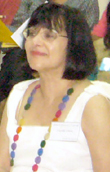 |
 |
Decorative Arts Workshop, Sri Lanka, 2009 |
At the end of November this year I was privileged to attend the second Decorative Arts Workshop to be held in Colombo, initiated and coordinated by Ayesha Abdur-Rahman. A chance email forwarded to me by a friend in the middle of the year led to my discovery of the Workshop and galvanised my long held plans to re-visit the country of my birth after an absence of thirty years. To my great delight, in correspondence with Ayesha we discovered that we had been at school together in the 1950s, |
|
and that she remembered me, and the work of my father, Aubrey Collette (a political cartoonist and foundation member of the ‘43 Group, Sri Lanka’s first Modernist painting movement). Research into his work and a desire to catalogue existing pieces in Sri Lanka were further motivations for my trip. The Workshop was held over three consecutive days in three comfortable and reasonably well-appointed venues – The Galle Face Hotel, The American Center and The Fullbright Center. The organizations that hosted and provided sponsorship were very hospitable in looking after the participants with lunches and afternoon teas. The initial presentation by Dr. SinhaRaja Tammita-Delgoda on “Decorating the Landscape, Ancient Sri Lanka and the use of Rock and Water as forms of Art”, set a high standard of thoughtful and visual delivery, and though subsequent varied presentations, the stage was set for the discussion of detailed scholarly information by people passionate about their subject matter. Over the next few days we learned about topics as varied as the depiction of objects in wall paintings found in the remains of the mediaeval Tivanka temple at Polonnaruwa (Ayesha Abdur-Rahman), the “Forgotten trade of Elephants as depicted in Dutch paintings and maps” (Professor K. D. Paranavitana) and “Angels in Sri Lankan Buddhist Art” (Bindu Urugodawatta). As an Australian Ceylonese of Dutch Burgher descent I was particularly interested in the Workshop’s insights into the period of Dutch occupation and the legacy of its art and architecture. Presenters from the Rijksmuseum in Amsterdam as well as local scholars provided enlightenment. Of particular interest was a presentation by Martine Gosselink, head of the History Department of the Rijksmuseum, about a comprehensive website she has set up - “An Atlas of Shared Heritage”- which documents and disseminates information including maps, images of works of art and architecture covering the entire Dutch Colonial period worldwide, and is a tremendously valuable resource. Ashley de Vos, a local architect and historian argued that Dutch “Architecture” in Sri Lanka was confined to churches, warehouses and forts and led a bus tour to the 17thC. Dutch Church, Wolvendaal, and the Dutch Museum to assess their architectural merit. My other area of interest, Textiles, was covered comprehensively on the third day of the Workshop. As a tapestry weaver I am always fascinated by the form and structure of woven material as well as its design. Chandra Thenuwara, a locally esteemed textile technologist and artist spoke about the history of the Sri Lankan hand weaving industry and the Dumbara weavers and introduced us to the traditional styles incorporated in the intricate “diyakachchi” loincloth, ancient examples of which we were able to later view at the Colombo and Kandy museums and in contemporary reproduction in the Dumbara Valley. Textile expert from the UK, Dr. Steven Cohen delivered a well illustrated talk about the textile trade between India and Sri Lanka, introducing us to the beautiful Indian chintzes, somana tuppotiya, and the gold brocaded ceremonial kasav tuppotiya which we were also able to view at museums later. Examples of highly decorated canopies and temple cloths added visual impact to the knowledge he imparted in his presentation. Rosemary Crill, from the Victoria and Albert Museum in London spoke about Sri Lankan textiles in the collection and showed similar examples of banners and temple hangings, embroidered betel bags and garments acquired between 1855 and 2007. The third day was rounded out with a visit to the Colombo Museum where we were able to enter the storage archive and handle precious textile pieces under the supervision of a curator. A visit to the Sapumal Foundation followed, which houses the paintings of the ‘43 Group, and there I was able to see examples of my father’s work first hand, a tangible realisation of an emotional personal journey. I also participated in a three-day bus tour in and around Kandy along with the other International participants in the Workshop to view textile production and temple treasures first hand. This afforded the eight of us a more intimate experience of travelling and living together and the consequent sharing of ideas and expertise in a more informal way. I am grateful to have visited Sri Lanka with the Decorative Arts Workshop as a focus – it provided me not only with knowledge I will continue to pursue, but also the company of like- minded artists and scholars whom I will continue to correspond with and be inspired by. I congratulate Ayesha on creating such an interesting and varied program and I greatly look forward to attending future gatherings. Cresside Collette, January 2010.
|
|